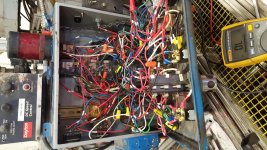Halabicky1
Member
Hello all, I have been in maintenance at my plant for 5 years now & progressed through the tiers to become a controls tech through several Allen Bradley training courses & on the job training. I am now at the point where I feel comfortable with my programming & PLCs in general.
However there is one panel in my plant where the machinery runs off old relay block controls & the wiring is a disaster (no labels left on wires jumpers everywhere.. ect.) we don't even have the original schematics. I'm not sure if this is even a question I should be asking on this forum, but I'm curious if anyone else has these same issues & what I could do to improve my understanding. Company just turned down a PLC upgrade because it costs too much money
As this is my first post & new to the forum please correct me if this is
However there is one panel in my plant where the machinery runs off old relay block controls & the wiring is a disaster (no labels left on wires jumpers everywhere.. ect.) we don't even have the original schematics. I'm not sure if this is even a question I should be asking on this forum, but I'm curious if anyone else has these same issues & what I could do to improve my understanding. Company just turned down a PLC upgrade because it costs too much money
As this is my first post & new to the forum please correct me if this is







